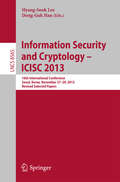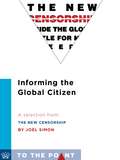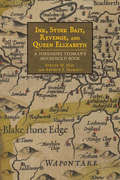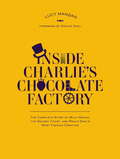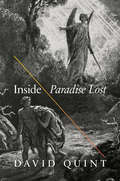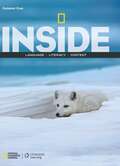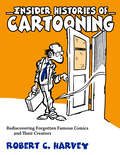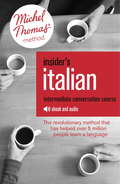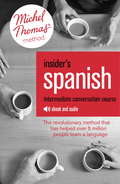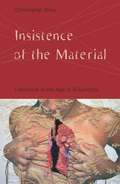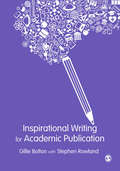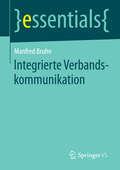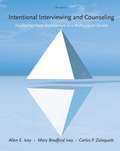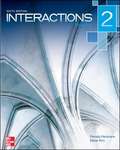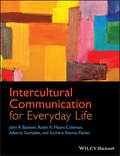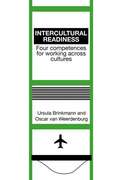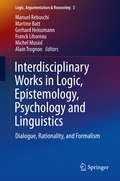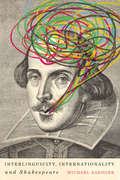- Table View
- List View
Information Security and Cryptology -- ICISC 2013
by Hyang-Sook Lee Dong-Guk HanThis book constitutes the thoroughly refereed post-conference proceedings of the 16th International Conference on Information Security and Cryptology, ICISC 2013, held in Seoul, Korea in November 2013. The 31 revised full papers presented together with 2 invited talks were carefully selected from 126 submissions during two rounds of reviewing. The papers provide the latest results in research, development and applications in the field of information security and cryptology. They are organized in topical sections on secure multiparty computation, proxy re-encryption, side channel analysis and its countermeasures, cryptanalysis, embedded system security and its implementation, primitives for cryptography, digital signature, security protocol, cyber security, and public key cryptography.
Informing the Global Citizen: A Selection from The New Censorship: Inside the Global Battle for Media Freedom (To the Point)
by Joel SimonToday, anyone with an iPhone can provide firsthand accounts from the world's front lines. Despite our increased access to events around the world, journalists are more vital than ever as they bring context and perspective and help to set the humanitarian agenda. However, threats to journalists are mounting with record numbers killed and imprisoned each year. From the drug wars of Mexico to Iraq and Tahrir Square, Joel Simon explores the new challenges and dangers to the future of journalistic freedom.
Informing the Global Citizen: Inside the Global Battle for Media Freedom
by Joel SimonToday, anyone with an iPhone can provide firsthand accounts from the world's front lines. Despite our increased access to events around the world, journalists are more vital than ever as they bring context and perspective and help to set the humanitarian agenda. However, threats to journalists are mounting with record numbers killed and imprisoned each year. From the drug wars of Mexico to Iraq and Tahrir Square, Joel Simon explores the new challenges and dangers to the future of journalistic freedom.
Informing the Global Citizen: Inside the Global Battle for Media Freedom
by Joel SimonToday, anyone with an iPhone can provide firsthand accounts from the world's front lines. Despite our increased access to events around the world, journalists are more vital than ever as they bring context and perspective and help to set the humanitarian agenda. However, threats to journalists are mounting with record numbers killed and imprisoned each year. From the drug wars of Mexico to Iraq and Tahrir Square, Joel Simon explores the new challenges and dangers to the future of journalistic freedom.
Ink, Stink Bait, Revenge, and Queen Elizabeth: A Yorkshire Yeoman's Household Book
by Steven W. May Arthur F. MarottiIn Ink, Stink Bait, Revenge, and Queen Elizabeth, Steven W. May and Arthur F. Marotti present a recently discovered "household book" from sixteenth-century England. Its main scribe, John Hanson, was a yeoman who worked as a legal agent in rural Yorkshire. His book, a miscellaneous collection of documents that he found useful or interesting, is a rare example of a middle-class provincial anthology that contains, in addition to works from the country's cultural center, items of local interest seldom or never disseminated nationally. Among the literary highlights of the household book are unique copies of two ballads, whose original print versions have been lost, describing Queen Elizabeth's procession through London after the victory over the Spanish Armada; two poems attributed to Elizabeth herself; and other verse by courtly writers copied from manuscript and print sources. Of local interest is the earliest-known copy of a 126-stanza ballad about a mid-fourteenth-century West Yorkshire feud between the Eland and Beaumont families. The manuscript's utilitarian items include a verse calendar and poetic Decalogue, model legal documents, real estate records, recipes for inks and fish baits, and instructions for catching rabbits and birds. Hanson combined both professional and recreational interests in his manuscript, including material related to his legal work with wills and real estate transactions.As May and Marotti argue in their cultural and historical interpretation of the text, Hanson's household book is especially valuable not only for the unusual texts it preserves but also for the ways in which it demonstrates the intersection of the local and national and of popular and elite cultures in early modern England.
Inside Charlie's Chocolate Factory
by Lucy ManganCelebrate the 50 years of Charlie and the Chocolate Factory with this scrumdiddlyumptious book about the iconic novel and author! Inside Charlie's Chocolate Factory explores the unique appeal and lasting cultural impact of Roald Dahl's beloved classic. This non-fiction book looks at the development of the original story and charaters, its social history, and the varying film and stage adaptations. With never-before-seen material from the archives, full-color photos and illustrations throughout, and quotes from Roald Dahl enthusiasts this gorgeously produced gift book is a great way for fans to celebrate Charlie, Wonka, and Roald Dahl!
Inside Paradise Lost: Reading the Designs of Milton's Epic
by David QuintInside "Paradise Lost" opens up new readings and ways of reading Milton's epic poem by mapping out the intricacies of its narrative and symbolic designs and by revealing and exploring the deeply allusive texture of its verse. David Quint’s comprehensive study demonstrates how systematic patterns of allusion and keywords give structure and coherence both to individual books of Paradise Lost and to the overarching relationship among its books and episodes. Looking at poems within the poem, Quint provides new interpretations as he takes readers through the major subjects of Paradise Lost—its relationship to epic tradition and the Bible, its cosmology and politics, and its dramas of human choice.Quint shows how Milton radically revises the epic tradition and the Genesis story itself by arguing that it is better to create than destroy, by telling the reader to make love, not war, and by appearing to ratify Adam’s decision to fall and die with his wife. The Milton of this Paradise Lost is a Christian humanist who believes in the power and freedom of human moral agency. As this indispensable guide and reference takes us inside the poetry of Milton’s masterpiece, Paradise Lost reveals itself in new formal configurations and unsuspected levels of meaning and design.
Inside: Reading & Language [Level A]
by Michael W. Smith Deborah J. Short David W. MooreFeatures motivating content in 8 units, all at an appropriate reading level and valuable supports for accessing texts
Inside: Reading & Language [Level C]
by Michael W. Smith Deborah J. Short David W. MooreFeatures motivating content in 8 units, all at an appropriate reading level and valuable supports for accessing texts
Inside: Reading and Language, Level C
by Deborah J. Short David W. Moore Josefina Villamil Tinajero Alfred W. Tatum Gretchen BernabeiStandards-based language and literacy instruction with specialized strategies for English learners and struggling readers. Comprehensive instruction and accessible content delivered in overlapping levels make it possible to meet English learners and struggling readers at their language and reading levels, and rapidly move them to grade-level performance.
Insider Histories of Cartooning: Rediscovering Forgotten Famous Comics and Their Creators
by Robert C. HarveyMany fans and insiders alike have never heard of Bill Hume, Bailin' Wire Bill, Abe Martin, AWOL Wally, the Texas History Movies, or the Weatherbird at the St. Louis Post-Dispatch. And many insiders do not know why we call comic books “comics” even though lots of them are not at all funny. Robert C. Harvey, cartoonist and a veteran comics critic, author of several histories of comics and biographies of cartoonists, tells forgotten stories of a dozen now obscure but once famous cartoonists and their creations. He also includes accounts of the cartooning careers of a groundbreaking African American and a woman who broke into an industry once dominated by white men. Many of the better-known stories in some of the book's fourteen chapters are wrapped around fugitive scraps of information that are almost unknown. Which of Bill Mauldin's famous duo is Willie? Which is Joe? What was the big secret about E. Simms Campbell? Who was Funnyman? And why? And some of the pictures are rare, too. Hugh Hefner's cartoons, Kin Hubbard's illustrations for Short Furrows, Betty Swords’s pictures for the Male Chauvinist Pig Calendar of 1974, the Far East pin-up cartoon character Babysan, illustrations for Popo and Fifina, and Red Ryder's last bow.
Insider's Italian (Learn Italian with the Michel Thomas Method): Enhanced Ebook
by Michel Thomas Paola TiteDo you want to be able to express yourself in Italian with confidence and fluency?Insider's Italian offers a local perspective on Italian culture, opinions and language use so that you can speak confidently on today's most important and relevant topics. This intermediate Italian conversation course, devised for all intermediate-level learners or those following on from Total or Perfect Italian, will advance your overall fluency, listening comprehension and conversation skills, expand your vocabulary and improve your grammar. Through authentic, lively conversations around engaging topics, and the unique Michel Thomas Method for learning, this course focuses on the colloquial language and conversation strategies used by native Italian speakers so that you can fit in and communicate more naturally.Michel Thomas, the preeminent language teacher, always said that learners start by mastering basic linguist structures (as in his Total and Perfect courses), which provide the bare walls of the house, but that that it was up to us, the learner, to decorate it in our own personal way. Insider's Italian reflects Michel Thomas's 'Phase 2' courses that he and his team offered at his New York language school, allowing increased vocabulary, improved speaking, comprehension and reading and writing skills - the tools with which to decorate their houses.Insider's Italian includes:· Twenty authentic conversations around a comprehensive range of subjects that reflect contemporary Italian culture· Language plus: conversation strategies, pronunciation and intonation to help learners express themselves naturally· Listening and speaking practice to help learners progress to the next level· Cultural insights into the unspoken rules of the language This ebook includes 10 chapters with integrated audio conversations.Why is the Michel Thomas Method so successful?The Michel Thomas Method draws on the principles of instructional psychology. Knowledge is structured and organised for the student so that you assimilate the language easily and don't forget it. The method deconstructs the language into building blocks that are introduced sequentially in such a way that the learner creates his/her response and moves on to ever-more-complex sentences. Michel said: I will dissect everything into small parts and reassemble it in such a way that one will understand everything step by step.He was also very clear about his ground rules: no memorisation, no drills, no homework; relax and leave off the anxiety normally associated with language learning.
Insider's Spanish (Learn Spanish with the Michel Thomas Method): Enhanced Ebook
by Michel Thomas Virginia Catmur Jennifer Stanley-SmithDo you want to be able to express yourself in Spanish with confidence and fluency?Insider's Spanish offers a local perspective on Spanish culture, opinions and language use so that you can speak confidently on today's most important and relevant topics. This intermediate Spanish conversation course, devised for all intermediate-level learners or those following on from Total or Perfect Spanish, will advance your overall fluency, listening comprehension and conversation skills, expand your vocabulary and improve your grammar. Through authentic, lively conversations around engaging topics, and the unique Michel Thomas Method for learning, this course focuses on the colloquial language and conversation strategies used by native Spanish speakers so that you can fit in and communicate more naturally.Michel Thomas, the preeminent language teacher, always said that learners start by mastering basic linguist structures (as in his Total and Perfect courses), which provide the bare walls of the house, but that that it was up to us, the learner, to decorate it in our own personal way. Insider's Spanish reflects Michel Thomas's 'Phase 2' courses that he and his team offered at his New York language school, allowing increased vocabulary, improved speaking, comprehension and reading and writing skills - the tools with which to decorate their houses.Insider's Spanish includes:· Twenty authentic conversations around a comprehensive range of subjects that reflect contemporary Spanish culture· Language plus: conversation strategies, pronunciation and intonation to help learners express themselves naturally· Listening and speaking practice to help learners progress to the next level· Cultural insights into the unspoken rules of the language This ebook includes 10 chapters with integrated audio conversations.Why is the Michel Thomas Method so successful?The Michel Thomas Method draws on the principles of instructional psychology. Knowledge is structured and organised for the student so that you assimilate the language easily and don't forget it. The method deconstructs the language into building blocks that are introduced sequentially in such a way that the learner creates his/her response and moves on to ever-more-complex sentences. Michel said: I will dissect everything into small parts and reassemble it in such a way that one will understand everything step by step.He was also very clear about his ground rules: no memorisation, no drills, no homework; relax and leave off the anxiety normally associated with language learning.
Insistence of the Material: Literature in the Age of Biopolitics
by Christopher BreuInsistence of the Material engages with recent theories of materiality and biopolitics to provide a radical reinterpretation of experimental fiction in the second half of the twentieth century. In contrast to readings that emphasize the metafictional qualities of these works, Christopher Breu examines this literature&’s focus on the material conditions of everyday life, from the body to built environments, and from ecosystems to economic production. In Insistence of the Material, Breu rethinks contemporary understandings of biopolitics, affirming the importance of forms of materiality that refuse full socialization and resist symbolic manipulation. Breu considers a range of novels that reflect questions of materiality in a biopolitical era, including William Burroughs&’s Naked Lunch, Thomas Pynchon&’s V., J. G. Ballard&’s Crash, Dodie Bellamy&’s The Letters of Mina Harker, and Leslie Marmon Silko&’s Almanac of the Dead. Drawing from accounts of the emergence of immaterial production and biopolitics by Michel Foucault, Giorgio Agamben, Roberto Esposito, and Michael Hardt and Antonio Negri, Breu reveals the confrontational dimensions of materiality itself in a world devoted to the idea of its easy malleability and transcendence.Taking his analysis beyond the boundaries of literature, Breu argues that both materiality and subjectivity form sites of resistance to biopolitical control and that new developments in materialist theory advance a conception of social existence in which materiality—rather than language or culture—is the central term.
Inspirational Writing for Academic Publication
by Gillie E Bolton Stephen RowlandDo you feel under increasing pressure to produce high quality publications, or struggle to translate your great ideas into inspirational - and engaging - writing? Gillie Bolton introduces her three 'key phases' method (Write for Myself, Redraft for my Reader, Edit for Posterity) to make the writing process less daunting, and offers support and advice on how to develop your own writing voice to use this to engage readers in your research. 'Characters' at different career stages help you to identify your own writing level, and before and after examples of work from a range of disciplines clearly illustrate the key writing techniques. Drawing on case studies, as well as their own extensive writing experience, the authors suggest strategies for dealing with common difficulties such as: Time and energy management Restoring flagging enthusiasm Maintaining inspiration Dealing with potential burnout and writer's block. Each chapter concludes with a set of constructive exercises which develop these critical skills and inspire you to improve and enjoy your own academic writing. Ideal for upper level students and early career researchers. Dr Gillie Bolton is an international authority on writing and author of a long publication list including nine books, academic papers, as well as professional articles, poetry, and for a lay readership. Stephen Rowland, Emeritus Professor of University College London, is author of four books on the nature of research and learning in a range of contexts.
Inspiring Fellini
by Federico PacchioniFederico Fellini is considered one of the greatest cinematic geniuses of our time, but his films were not produced in isolation. Instead, they are the results of collaborations with some of the greatest scriptwriters of twentieth-century Italy. Inspiring Fellini re-examines the filmmaker's oeuvre, taking into consideration the considerable influence of his collaborations with writers and intellectuals including Pier Paolo Pasolini, Ennio Flaiano, Tullio Pinelli, and Andrea Zanzotto. Author Federico Pacchioni provides a portrait of Fellini that is more complex than one of the stereotypical solitary genius, as he has been portrayed by Fellini criticism in the past. Pacchioni explores the dynamics of Fellini's cinematic collaborations through analyses of the writers' independently produced works, their contributions to the conceptualization of the films, and their conversations with Fellini himself, found in public and private archival sources. This book is an invaluable resource in the effort to understand the genesis of Fellini's artistic development.
Integrierte Verbandskommunikation (essentials)
by Manfred BruhnVerbände haben sich mit einer Vielzahl unterschiedlicher Anspruchsgruppen auseinanderzusetzen. Zudem existieren verschiedene Möglichkeiten der Kommunikation bzw. der Zielgruppenansprache. Die Relevanz einer Integrierten Kommunikation über alle Kommunikationsinstrumente ist daher unbestritten. Der Beitrag zeigt auf, wie die Besonderheiten der Verbandskommunikation im Rahmen einer Integrierten Kommunikation Berücksichtigung finden. Zudem werden Erfolgsbeispiele von Verbänden aufgezeigt, die eine effektive und effiziente Integrierte Kommunikation erfolgreich in der Praxis umsetzen.
Intentional Interviewing and Counseling: Facilitating Client Development in a Multicultural Society, 8th Edition
by Allen E. Ivey Mary Bradford Ivey Carlos P. ZalaquettMaster interviewing skills with INTENTIONAL INTERVIEWING AND COUNSELING: FACILITATING CLIENT DEVELOPMENT IN A MULTICULTURAL SOCIETY, 8th Edition. This book gives you the tools to adapt your skills to address both individual and multicultural uniqueness, conduct interviews using five different theoretical approaches, and begin developing a personalized style and theory of interviewing and counseling that matches your own aptitudes and affinities. Case studies, sample interviews, and a "Portfolio of Competencies" are just a few of the many tools that will help you master the material and become a better listener. Available with InfoTrac Student Collections http://gocengage. com/infotrac.
Interactions 2 Reading
by Elaine Kirn Pamela HartmannInteractions Level 2 Reading Student Book, 6th ed prepares students for college life through intensive skill development, extensive vocabulary work, and modern content. It teaches the skills and vocabulary that students need for success in university courses.
Intercultural Communication for Everyday Life
by John R. Baldwin Suchitra Shenoy-Packer Robin R. Coleman Alberto Gonzal¿zWritten for students studying intercultural communication for the first time, this textbook gives a thorough introduction to inter- and cross-cultural concepts with a focus on practical application and social action. Provides a thorough introduction to inter- and cross-cultural concepts for beginning students with a focus on practical application and social action Defines “communication” broadly using authors from a variety of sub disciplines and incorporating scientific, humanistic, and critical theory Constructs a complex version of culture using examples from around the world that represent a variety of differences, including age, sex, race, religion, and sexual orientation Promotes civic engagement with cues toward individual intercultural effectiveness and giving back to the community in socially relevant ways Weaves pedagogy throughout the text with student-centered examples, text boxes, applications, critical thinking questions, a glossary of key terms, and online resources for students and instructors Online resources for students and instructors available upon publication at www.wiley.com/go/baldwin
Intercultural Readiness
by Ursula Brinkmann Oscar Van WeerdenburgDrawing on research from 30,000 individuals and their practical experience as intercultural management consultants, the authors provide insights into the broader landscape of intercultural management through their exploration of 4 competencies: Intercultural Sensitivity, Intercultural Communication, Building Commitment and Managing Uncertainty.
Interdisciplinary Works in Logic, Epistemology, Psychology and Linguistics
by Gerhard Heinzmann Franck Lihoreau Manuel Rebuschi Martine Batt Michel Musiol Alain TrognonThis book presents comparisons of recent accounts in the formalization of natural language (dynamic logics and formal semantics) with informal conceptions of interaction (dialogue, natural logic and attribution of rationality) that have been developed in both psychology and epistemology. There are four parts which explore: historical and systematic studies; the formalization of context in epistemology; the formalization of reasoning in interactive contexts in psychology; the formalization of pathological conversations. Part one discusses the Erlangen School, which proposed a logical analysis of science as well as an operational reconstruction of psychological concepts. These first chapters provide epistemological and psychological insights into a conceptual reassessment of rational reconstruction from a pragmatic point of view. The second focus is on formal epistemology, where there has recently been a vigorous contribution from experts in epistemic and doxatic logics and an attempt to account for a more realistic, cognitively plausible conception of knowledge. The third part of this book examines the meeting point between logic and the human and social sciences and the fourth part focuses on research at the intersection between linguistics and psychology. Internationally renowned scholars have contributed to this volume, building on the findings and themes relevant to an interdisciplinary scientific project called DiaRaFor ("Dialogue, Rationality, Formalisms") which was hosted by the MSH Lorraine (Lorraine Institute for Social Sciences and Humanities) from 2007 to 2011.
Interlinguicity, Internationality, and Shakespeare
by Michael SaengerLanguages have become more mobile than ever before, producing translations, transplantations, and cohabitations of all kinds. The early modern period also witnessed profound linguistic transformation, but in very different ways. Interlinguicity, Internationality, and Shakespeare undoes the illusion that Shakespeare wrote in what we now think of as English. In a series of essays approaching Shakespeare from unique and thought-provoking perspectives, contributors from history, performance criticism, and comparative literature look at "interlinguicity," the condition of being between languages, and "internationality," the condition of being between countries. Each essay focuses on local issues, such as community identification in the Netherlands of Shakespeare's time and the appropriation of Shakespeare in German literature in the nineteenth century, to suggest that Shakespeare never wrote "in" English because English was not then, nor is it now, an intact, knowable system. Many languages existed in sixteenth-century London, and English did not have clear limits. Interlinguicity, Internationality, and Shakespeare helps to explain the hybridity that Shakespeare embraced in all his writing. Contributors include Paula Blank (College of William and Mary), Lauren Coker (Saint Louis University), Brian Gingrich (Princeton University), Alexa Huang (George Washington University), James Loehlin (University of Texas at Austin), Scott Newstok (Rhodes College), Patricia Parker (Stanford University), Elizabeth Pentland (York University), Philip Schwyzer (University of Exeter), Gary Waite (University of New Brunswick), and Robert N. Watson (University of California, Los Angeles)
